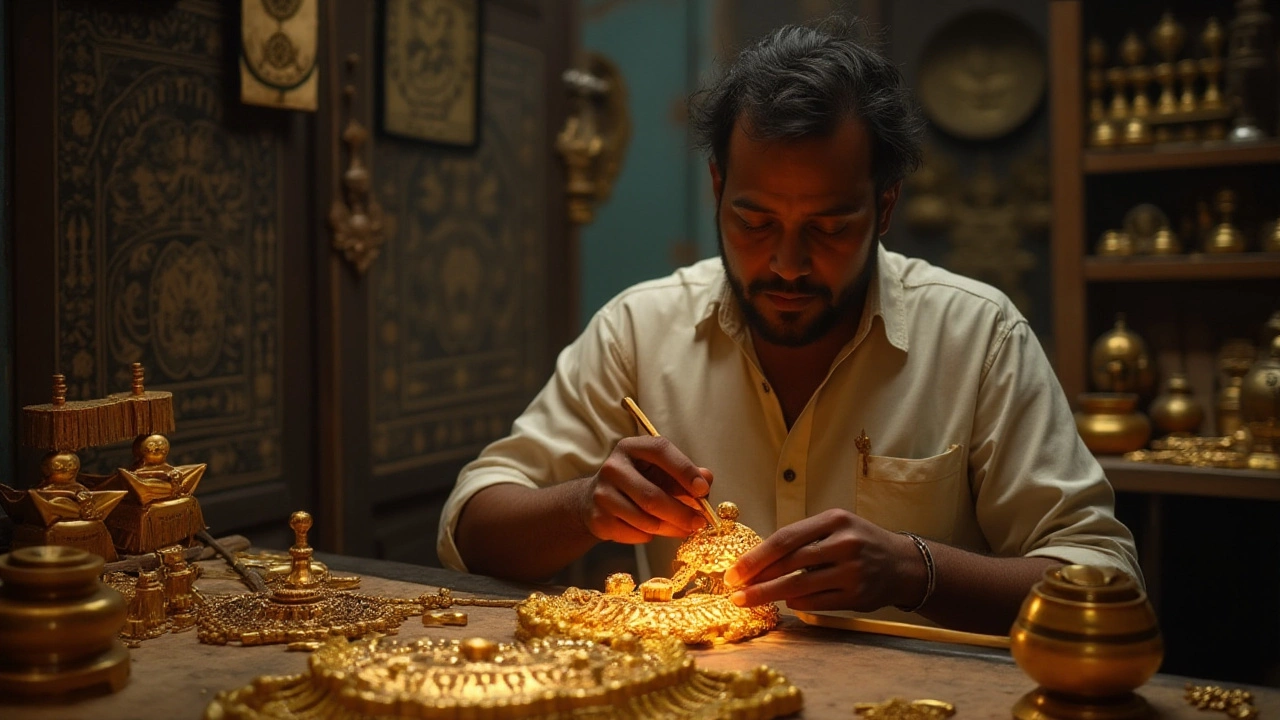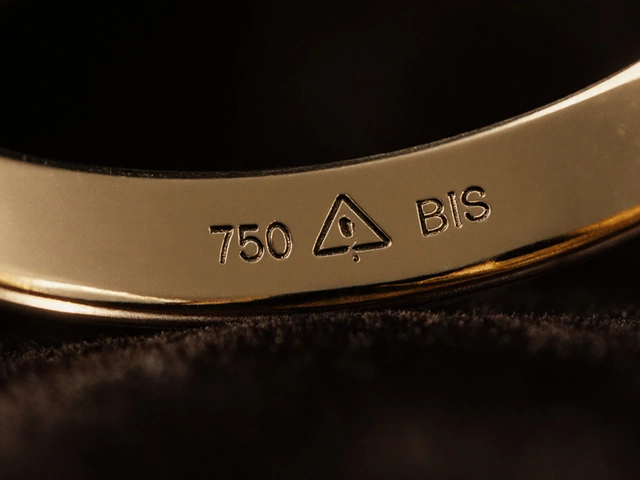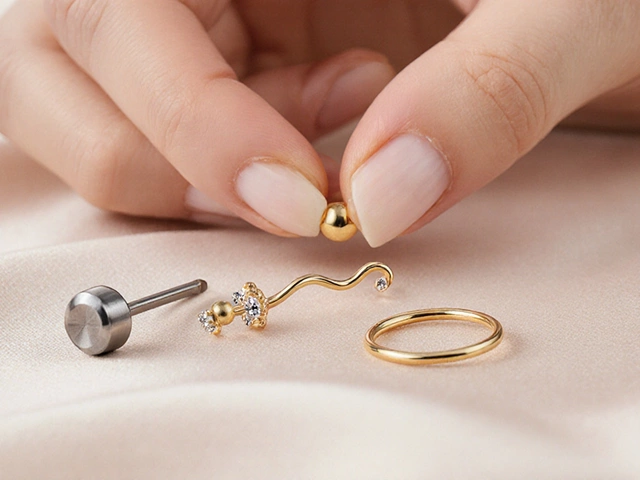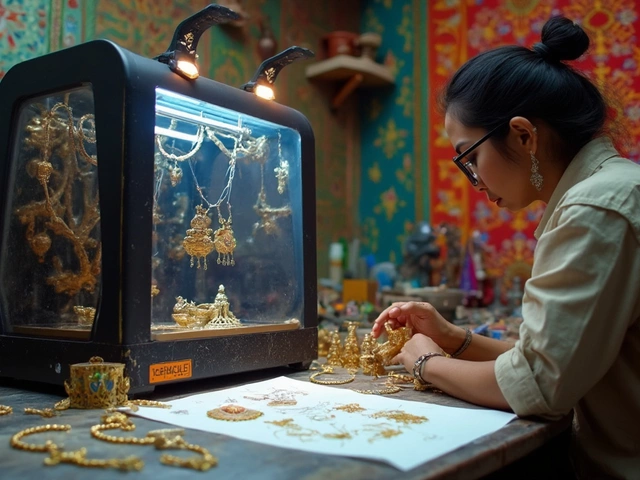Temple jewellery in India isn't just about beauty; it's a deep-rooted tradition that carries immense cultural pride. When it comes to selecting the right gold for these exquisite pieces, many factors come into play—from the purity of the gold to its hue and resilience.
In India, the choice of gold is often linked to its spiritual and cultural significance, reflecting a plethora of beliefs and traditional values. As such, understanding the nuances of different types of gold becomes essential, not only for the craft itself but for personal satisfaction and legacy.
This exploration will help demystify the elements of gold purity, popular types of gold prevalent in India, and how these options align with both tradition and modern aesthetics. Coupled with insights into regional preferences and the remarkable skills of artisans, this guide aims to inform and inspire anyone interested in temple jewellery.
- The Rich Tradition of Temple Jewellery
- Understanding Gold Purity and Karats
- The Popular Types of Gold in India
- Choosing Gold for Durability and Aesthetics
- Regional Preferences in Temple Jewellery
- Craftsmanship and Design Considerations
The Rich Tradition of Temple Jewellery
Temple jewellery in India carries a legacy as profound as the deities it adorns. Originating from South Indian craftsmanship, these pieces were initially crafted to embellish idols and statues in historic temples, serving both as offerings to gods and as expressions of devotion. Over centuries, this form of jewellery has transcended its original ceremonial purpose, becoming integral to various cultural events, from weddings to classical dance performances.
The intricate designs of temple jewellery often feature religious motifs such as the lotus, the conch, and the sacred peacock, each element steeped in spiritual symbolism. These motifs are not merely decorative but tell stories of ancient lore, beliefs, and traditions. Crafted typically from high-purity gold, each piece undergoes a meticulous process of design and execution, which reflects the artisan's deep respect for the tradition. The distinct use of gold is both a nod to its divine association and a testament to its enduring allure and durability.
As temple jewellery became more fashionable, it started influencing mainstream jewellery design across India. The way these pieces blend heritage with artistry makes them timeless, and they remain a staple in bridal collections and traditional attire. According to a statement by renowned jewellery designer, Lakshmi Shankar, "Temple jewellery is more than ornamentation; it is a living museum of our culture."
Temple jewellery is more than ornamentation; it is a living museum of our culture.
The process of crafting temple jewellery demands a mastery that has been handed down through generations of skilled artisans. Using age-old techniques, they often combine gold with other elements like rubies, emeralds, and pearls to create magnificent, elaborate ornaments. Their expertise ensures that each piece is as durable as it is beautiful, capable of lasting for generations as heirlooms passed down through families. The artistry involved in temple jewellery offers a glimpse into the cultural richness and traditional values cherished by Indian society. Today, while much has modernized, the essence of temple jewellery remains untouched, continuing to be a vital part of cultural identity and heritage.
This jewellery is not just about opulence; it holds an emotion that links individuals to their ancestry. Across the various regions in India, the style, technique, and type of gold used might vary, yet the heart of temple jewellery beats strongly with a shared sense of reverence and heritage. This connection to the past and the spiritual symbolism makes it deeply cherished, ensuring its place in the fabric of Indian culture.
Understanding Gold Purity and Karats
Gold purity can often seem like an esoteric subject to the uninitiated, yet it holds paramount importance in the world of temple jewellery in India. At its core, gold purity is all about the metal's authenticity and lack of impurities. It's often measured in karats, a term that indicates how much pure gold is present in an alloy. In India, the most common purities include 22-karat, 18-karat, and occasionally 24-karat gold, each bringing its own set of qualities to the table.
22-karat gold consists of approximately 91.6% pure gold, mixed with alloys like silver and copper to enhance durability. This is the most preferred choice for temple jewellery, marrying the brilliance of gold with the robustness necessary for intricate designs. On the other hand, 18-karat gold has around 75% pure gold and is often used for pieces that demand a balance between purity and strength. Interestingly, 24-karat is pure gold but is rarely used in jewellery due to its softness, making it impractical for durable wearables.
"Understanding the nuances between different karats of gold allows one to appreciate the art and cultural elements that go into creating temple jewellery," says renowned jewellery historian Geeta Mehta.
The choice of karat often aligns with cultural and regional preferences. In Southern India, for example, there's a stronger inclination towards higher karat gold, reflecting the state's historical affluence and reverence for the metal. Meanwhile, Northern India might lean towards lesser karats in favour of versatility and affordability. These decisions aren't arbitrary but are steeped in traditions that have been handed down through generations.
One should also consider hallmarking, which is an assurance of quality and purity. India mandates the BIS (Bureau of Indian Standards) hallmark on gold, which not only guarantees the karatage but also reinforces the metal's authenticity, thus protecting consumers. Temple jewellery often bears this hallmark, ensuring that what you're investing in reflects genuine purity and craftsmanship.
Ultimately, understanding gold purity is a journey into the art and science behind one of history’s most treasured metals. Whether it's the exquisite hue of 22-karat or the enduring nature of 18-karat, each type tells its own story, making it an integral part of both aesthetic and cultural identity in India.
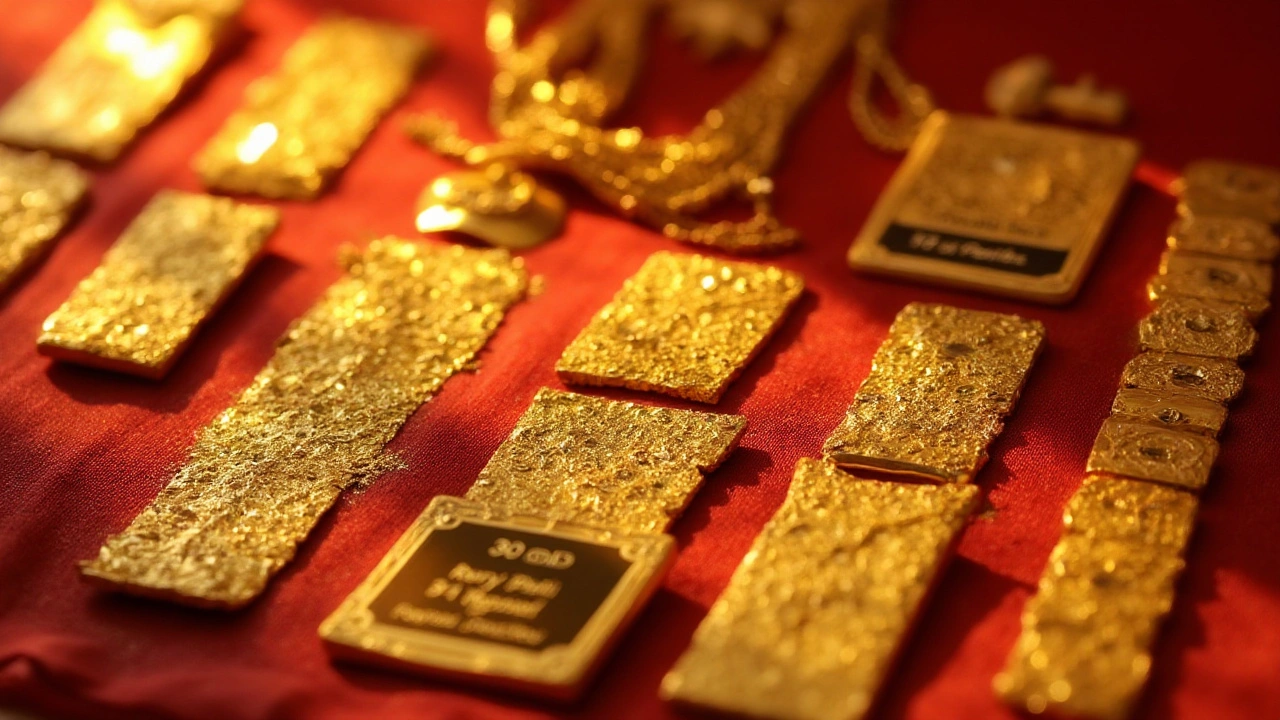
The Popular Types of Gold in India
When we talk about gold in India, it's not just a mere commodity; it's intertwined with the nation's identity and heritage. From age-old traditions to modern-day celebrations, the type of gold used in creation of jewelry, particularly temple jewellery, plays a crucial role. The primary types of gold used include 24-karat gold, 22-karat gold, 18-karat gold, and even white and rose gold variants. Each has its characteristics, uses, and levels of appeal.24-karat gold is the purest form, comprising nearly 99.9% gold. While it is often sought after for its unparalleled luster and purity, its softness makes it less ideal for intricate designs and durability demands seen in jewelry. Its allure remains strong for ceremonial pieces and certain temple idol designs due to its unmatched shine.22-karat gold, which contains around 91.6% gold mixed with other metals like copper or silver, finds favor in jewelry making. The addition of other metal alloys strengthens the gold, making it more suitable for detailed designs and durable wear. This gold type strikes an appealing balance between purity and strength, making it a household choice across India.
In the pursuit of contemporary designs and affordability, 18-karat gold has steadily garnered attention. It consists of 75% pure gold and 25% other metals, offering an eclectic range of colors and designs. The lower purity allows for more robust pieces, though it doesn't possess the same historical gravity as higher karats. For fashionable pieces requiring a lower price point, it remains an attractive option.
The Rise of White and Rose Gold
White gold and rose gold are modern favorites, particularly among the younger generation. White gold is formed by alloying gold with metals like palladium or nickel, providing a silvery sheen akin to platinum, infusing modern aesthetics with tradition. Meanwhile, rose gold—an alloy of gold with a notable amount of copper—offers a warm, reddish color not typically associated with traditional Indian artifacts. These variants are gaining traction in the bridal market, fashion shows, and urban designs, yet temple jewellery with these kinds of gold remains rare but innovatively emerging.
As stated by Jayesh Sanghvi, a renown jewellery designer,
"In India, every gold type narrates its own story; it is about choosing the one that resonates with your heritage and personal story."
The choice among these types is not merely a matter of personal preference but is often influenced by regional traditions, religious rituals, and the intended purpose of the jewellery. Historically, communities in Southern India prefer 22-karat gold for temple jewellery because of its richness and ability to hold intricate designs without compromising strength. North Indian preferences are more varied, often embracing the diverse magic of 18-karat concoctions, particularly for multi-functional adornments.
Choosing Gold for Durability and Aesthetics
When it comes to picking the perfect type of gold for temple jewellery, two factors often take precedence: durability and aesthetics. These are crucial, not only because they affect how long your jewellery lasts, but also how attractive it looks over time. The gold’s purity, often measured in karats, plays a significant role here. Typically, 22-karat gold, consisting of around 91.6% pure gold, strikes a delicate balance between beauty and strength, making it a popular choice across many regions in India. While 24-karat gold might catch the eye with its rich luster and pure composition, its softness makes it less suited for pieces that demand intricate detailing or regular wear. By contrast, lower karats like 18K bring in metals such as copper or silver, enhancing durability without sacrificing too much shine.
Understanding the interplay between different gold alloys and their respective virtues becomes essential in making an informed choice. It’s not just about the karat number but also about what metals are mixed in and how that affects the gold’s properties. For example, the addition of copper not only boosts durability but can also lend a warm, reddish glow to the metal, an aesthetic highly valued in many traditional temple designs. Meanwhile, incorporating zinc or silver tends to light up the structure and impart a pale yellow hue that appeals in contemporary settings. A quote by the renowned jeweler, T.S. Kalyanaraman, encapsulates the essence, "Gold speaks a universal language of beauty, yet its essence lies in the tradition and innovation each alloy brings to life."
When thinking about aesthetics, details such as color, finish, and design intricacies are paramount. Temple jewellery often captivates with its elaborate designs, featuring motifs of deities, floral patterns, and mythological elements. Here, the gold’s ability to hold detailed engravings and its capacity to endure delicate filigree work without losing form is critical. In recent years, there’s been an increased appreciation for antique-finish gold, which provides a unique earthly look that echoes historical adornments. Considering how the finish and design will resonate with your personal style or the occasion becomes an enjoyable yet thoughtful endeavor.
Exploring traditional preferences while keeping a finger on modern trends helps tailor your choice to fit both personal taste and lasting relevance. While certain regions might favor the classic allure of yellow gold, others are veering towards white or rose gold, emphasizing the timeless charm yet offering modern aesthetics. Each region, from Kerala to Tamil Nadu, brings its signature flourish and flair, often impacted by local artistry and history. This results in a diverse tapestry of temple jewellery styles, where selecting the right kind of gold is as much about honoring local legacies as it is about personal expression. This mix of heritage and individual style ensures each piece is not just beautiful but meaningful, carrying forward stories through generations.
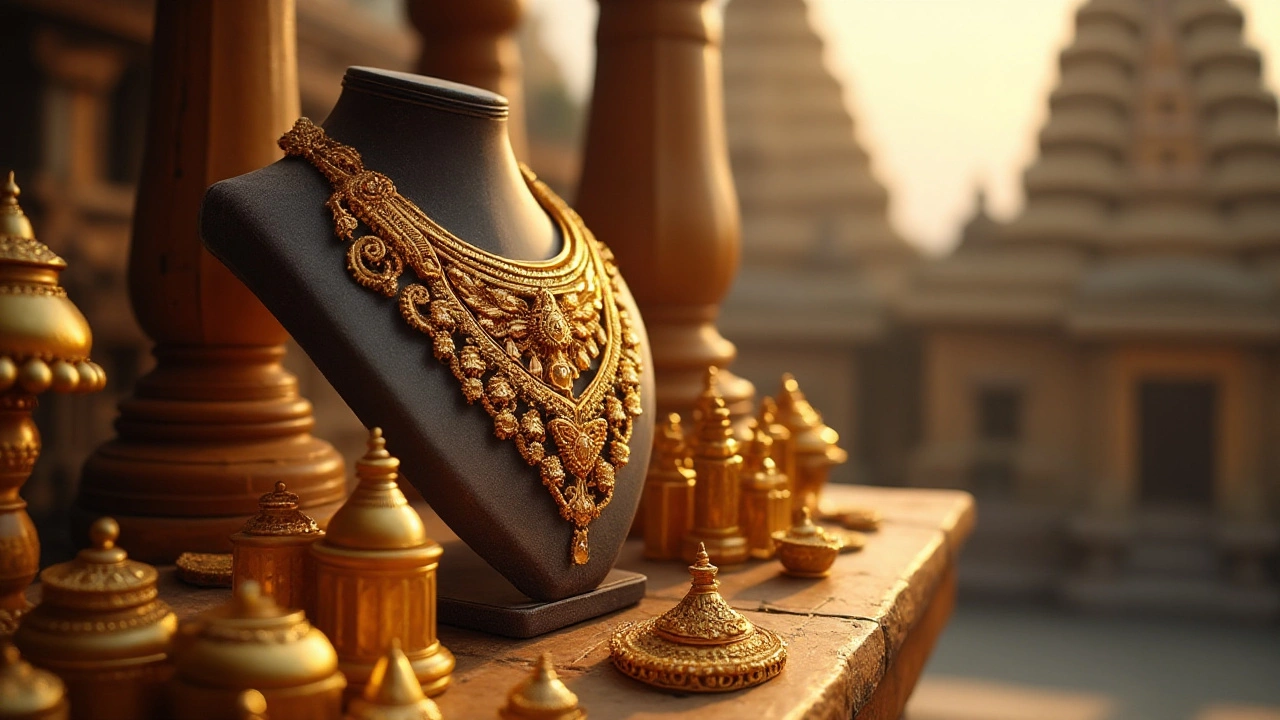
Regional Preferences in Temple Jewellery
India, with its diverse cultural tapestry, expresses its myriad traditions distinctly through temple jewellery. Each region harbors unique preferences that are often steeped in history and local craftsmanship. In South India, particularly in states like Tamil Nadu and Karnataka, temple jewellery is extra special, often incorporating intricate designs that depict gods, goddesses, and elements of nature. This region favors high-purity gold, often in the range of 22 karats, which is admired for its deep yellow tone. The communities here, especially during festivals or weddings, view these jewelleries as more than ornaments; they're relics that echo their rich Dravidian heritage.
Meanwhile, the western part of the country, including Gujarat and Maharashtra, tends to blend traditional motifs with modern design elements. Here, temple jewellery might also feature semi-precious stones, which adds a touch of color and distinction. While 22-karat gold is still the choice for many, there is a growing trend towards using 18-karat gold. This preference is often seen in pieces designed for urban wear, subtly blending historic influences with contemporary flair. A jeweller in Mumbai once mentioned, "Our designs aim to create a bridge between past elegance and today's fashion, making each piece timeless."
Moving north, the design principles transform yet again. Northern India, with its preference for opulence, opts for heavier pieces, adorned with rich carvings and often incorporating other precious metals and stones. The influences can be traced back to the Mughal era, where temple jewellery was more ornate and designed to exhibit royalty and splendor. Here, 22-karat gold still plays a significant role, although the emphasis can be equally distributed across the craftsmanship and the precious stones used.
In the eastern states such as West Bengal and Odisha, cultural preferences lean towards subtler styles, yet with extraordinary craftsmanship. Known for its filigree work, the jewellery from Odisha often uses gold to create intricate patterns that are light in weight but heavy with cultural significance. East’s preference slightly shifts towards 18-karat due to its affordability without compromising on elegance.
Temple jewellery's regional diversity showcases India's rich and varied culture and speaks volumes about its adaptability and timelessness. These varied designs speak a language of their own, narrating stories of ancient traditions and beliefs, passed down through generations. The craftsmanship of each part of India adds a fragment to the country's vast art history, making temple jewellery not just an accessory, but a narrative to be worn and cherished.
Craftsmanship and Design Considerations
Creating temple jewellery is an art form steeped in tradition, requiring a delicate balance between gold purity and intricate workmanship. Artisans, often belonging to families who have been in the trade for generations, learn the craft through an unbroken lineage of teaching. The expertise involved is a testament to their dedication and skill, with each piece meticulously crafted to ensure longevity and elegance. The process starts with hand-sketching designs that are both aesthetically pleasing and culturally significant. These designs are inspired by temple architecture, deities, and motifs that have been cherished through time. Engraving these intricate patterns into gold, while preserving its softness and shine, demands not only technical proficiency but an imaginative eye for detail.
Historically, temple jewellery would involve goldsmiths working closely with spiritual figures to ensure that each piece aligned with religious sentiments and mythologies. This historical collaboration is what lends temple jewellery its air of sacredness and reverence today. As a result, a significant amount of effort goes into selecting the type of gold used, often preferring 22-karat gold for its rich color and malleability. This type allows for exquisite detail in each piece while ensuring durability. The process of handcrafting involves melting the gold, casting it into sheets or wires, and then painstakingly shaping it through a series of tools and techniques. The fine detail achieved with limited technology is astonishing, reminiscent of a time when art was more about skill and time than on-screen precision.
"Temple jewellery gives narrative to our past and embodies the grandeur of Indian history through its devoted craftsmanship," says Dr. Aruna Jain, a renowned historian of Indian art.
The design consideration also includes incorporating regional variations, which add to the allure and authenticity of these masterpieces. In southern parts of India, for example, temple jewellery is adorned more with large, rounded beads and embossed intricate designs, while in the north, the designs might take on sharper, more angular motifs. Exploring these regional differences in design preferences is like diving into mini-cultures within the larger Indian context. This enriches not only the aesthetic value but also the emotional connection people have with the jewellery they choose, be it for rituals or as heritage pieces passed down through generations.
In the modern era, artisans have begun embracing technology to complement their age-old techniques. CAD designs, for instance, allow for experimentation with new patterns without compromising the craft's traditional essence. However, the heart of temple jewellery remains in its manually intensive creation process that celebrates the rich traditions of Indian artisanship. The design phase considers not only aesthetic harmony and cultural importance but also personal expression that resonates across ages. The selection and fusion of gold with other elements like gemstones also play a pivotal role in enhancing the grace of temple jewellery, ensuring that it remains a longstanding symbol of Indian heritage and pride.
